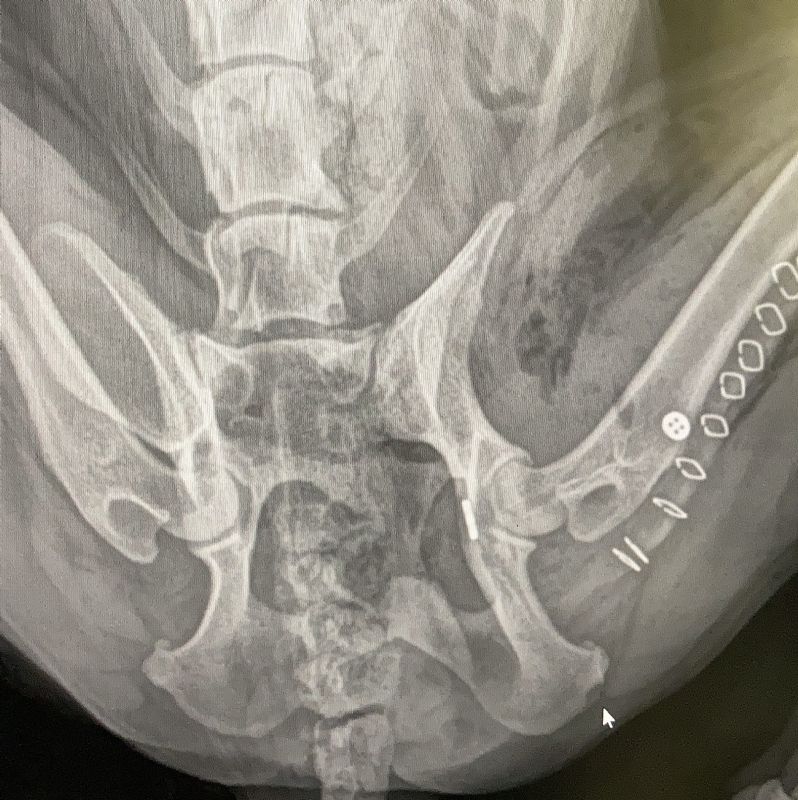- Home
- News, Articles & Reviews
We are hiring! Please click here to join our growing magazine delivery team in Gloucestershire!
Areas
Pets & Wildlife
Archive

Hip dislocation
All Areas > Pets & Wildlife > Pet Care
Author: Oliver Wilkinson, Posted: Tuesday, 25th May 2021, 09:00
This month I had the challenge of treating a young dog that had been hit by a car. The poor dog had suffered a dislocated hip as well as some minor abrasions.
Interestingly, in the human world, hip dislocations usually respond well to being put back in or replaced, and with careful management will go on to heal without further intervention. However, in dogs and cats, the hip is notoriously unstable once it has dislocated, and there is a high rate of repeat dislocation after putting back in place (this is called a closed reduction).
At least 50% of hips will dislocate again within days of a dislocation, leaving us with the challenge of how best to manage them. Historically, we would sometimes place the back leg into a sling to keep weight off the leg and keep the hip in the correct position. However, this is also fraught with complications, as the slings tend to be poorly tolerated by dogs and not at all by cats!
The ‘hip toggle’ procedure is one of the most reliable techniques
So, in many cases surgery is required, as was needed with my patient. One of the most reliable techniques is called a ‘hip toggle’ procedure. In this technique, a hole is drilled from the outside of the femur/hip to the centre of the ball joint. A long suture can be passed through this bone tunnel to exit in the centre of the ball joint and an anchor or toggle is placed at the end of the suture.
A hole is then drilled in the cup (pelvis) of the hip joint and the toggle/anchor is passed through the hole and secured on the far side. When the hip is then put back into position, the suture is pulled tight and secured with a button shaped device on the outside of the hip.
In the x-ray you can just make out a small metal toggle rod on the inside of the cup and the button on the outside of the hip. The row of metal staples that can be seen are skin staples used at the end of surgery.
This technique, while technically demanding, has a high success rate, with only a 5-10% risk of repeat dislocation of the hip joint, and most dogs and cats will use the leg quickly after surgery. Other options are to remove the ball joint altogether (an excision arthroplasty) or a hip replacement.
So far, my patient is doing well and was walking on the leg the day after surgery. The long-term prognosis with hip toggle surgery is generally extremely good.Copyright © 2025 The Local Answer Limited.
Unauthorized use and/or duplication of this material without express and written permission from this site's author and/or owner is strictly prohibited. Excerpts and links may be used, provided that full and clear credit is given to The Local Answer Limited and thelocalanswer.co.uk with appropriate and specific direction to the original content.More articles you may be interested in...


© 2025 The Local Answer Limited - Registered in England and Wales - Company No. 06929408
Unit H, Churchill Industrial Estate, Churchill Road, Leckhampton, Cheltenham, GL53 7EG - VAT Registration No. 975613000You are leaving the TLA website...
You are now leaving the TLA website and are going to a website that is not operated by us. The Local Answer are not responsible for the content or availability of linked sites, and cannot accept liability if the linked site has been compromised and contains unsuitable images or other content. If you wish to proceed, please click the "Continue" button below:




